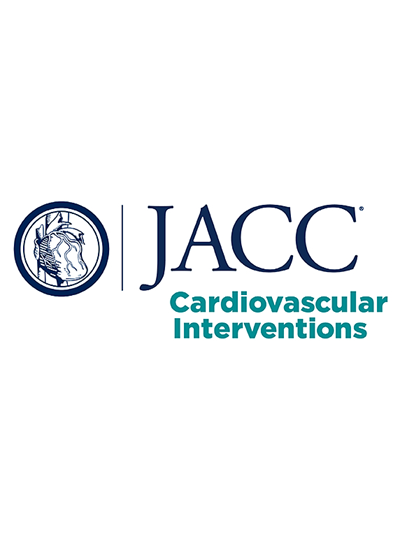经导管主动脉瓣置换术后血流动力学瓣膜恶化:发生率、预测因素和临床结果。
IF 11.7
1区 医学
Q1 CARDIAC & CARDIOVASCULAR SYSTEMS
引用次数: 0
摘要
背景:关于经导管主动脉瓣置换术(TAVR)假体耐久性的报道很少,并且由于不同的定义和相互竞争的死亡风险而混淆。目的:根据瓣膜学术研究联盟3的定义,作者试图确定TAVR后血流动力学瓣膜恶化(HVD)的发生率、预测因素和临床结果。方法:我们分析了2007年8月至2022年6月期间Bern TAVI(经导管主动脉瓣植入术)登记的连续TAVR患者的HVD发病率和预测因素,并根据HVD进行病例对照匹配以比较结果。结果共纳入2403例符合条件的患者(平均年龄81.8±6.2岁,胸外科学会预测死亡风险评分中位数为3.8% [Q1-Q3: 2.4%-6.0%]),中位随访时间为376天(Q1-Q3: 365- 1825天)。中度或重度HVD的累积发病率在1年、5年和10年分别为2.2% (95% CI: 1.6%-3.1%)、10.8% (95% CI: 9.2%-12.7%)和25.6% (95% CI: 17.5%-36.5%)。主动脉瓣复合体钙容量(HR: 1.81;95% ci: 1.11-2.97;P = 0.018),出院时主动脉残余反流(HR: 1.87;95% ci: 1.34-2.60;P < 0.001),口服抗凝剂治疗(HR: 1.78;95% ci: 1.00-3.15;P = 0.048)是HVD的独立预测因子。在病例对照匹配的队列中(HVD组,n = 155,无HVD组,n = 600), HVD患者的全因死亡率、心血管死亡率和感染性心内膜炎的年发生率相似,但重复主动脉瓣干预的发生率较高(比率比[RR]: 4.81 [95% CI: 1.74-13.26];P = 0.001)。结论:在tavr后的10年中,shvd发生率高达1 / 4,并与主动脉瓣再干预风险增加5倍相关。本文章由计算机程序翻译,如有差异,请以英文原文为准。
Hemodynamic Valve Deterioration After Transcatheter Aortic Valve Replacement
Background
Reports on the durability of transcatheter aortic valve replacement (TAVR) prostheses are scarce and confounded by varying definitions and competing risks of death.
Objectives
The authors sought to determine the incidence, predictors, and clinical outcomes of hemodynamic valve deterioration (HVD) according to the Valve Academic Research Consortium 3 definition after TAVR.
Methods
We analyzed consecutive patients undergoing TAVR in the prospective Bern TAVI (Transcatheter Aortic Valve Implantation) registry between August 2007 and June 2022 for the incidence and predictors of HVD and performed case control-matching to compare outcomes according to HVD.
Results
A total of 2,403 eligible patients (mean age 81.8 ± 6.2 years, median Society of Thoracic Surgeons Predicted Risk of Mortality score 3.8% [Q1-Q3: 2.4%-6.0%]) were included and had a median duration of follow-up of 376 days (Q1-Q3: 365-1,825 days). The cumulative incidence of moderate or severe HVD was 2.2% (95% CI: 1.6%-3.1%), 10.8% (95% CI: 9.2%-12.7%), and 25.6% (95% CI: 17.5%-36.5%) at 1, 5, and 10 years, respectively. Aortic valve complex calcium volume (HR: 1.81; 95% CI: 1.11-2.97; P = 0.018), residual aortic regurgitation at discharge (HR: 1.87; 95% CI: 1.34-2.60; P < 0.001), and treatment with oral anticoagulants (HR: 1.78; 95% CI: 1.00-3.15; P = 0.048) were independent predictors of HVD. In the case control-matched cohort (HVD, n = 155, no-HVD, n = 600), patients with HVD had similar yearly rates of all-cause and cardiovascular mortality, and infective endocarditis, but higher rates of repeat aortic valve intervention (rate ratio [RR]: 4.81 [95% CI: 1.74-13.26]; P = 0.001).
Conclusions
HVD occurred in up to 1 in 4 patients throughout 10-year post-TAVR and was associated with a 5-fold increase in the risk of aortic valve reintervention.
求助全文
通过发布文献求助,成功后即可免费获取论文全文。
去求助
来源期刊

JACC. Cardiovascular interventions
CARDIAC & CARDIOVASCULAR SYSTEMS-
CiteScore
11.60
自引率
8.80%
发文量
756
审稿时长
4-8 weeks
期刊介绍:
JACC: Cardiovascular Interventions is a specialist journal launched by the Journal of the American College of Cardiology (JACC). It covers the entire field of interventional cardiovascular medicine, including cardiac, peripheral, and cerebrovascular interventions. The journal publishes studies that will impact the practice of interventional cardiovascular medicine, including clinical trials, experimental studies, and in-depth discussions by respected experts. To enhance visual understanding, the journal is published both in print and electronically, utilizing the latest technologies.
 求助内容:
求助内容: 应助结果提醒方式:
应助结果提醒方式:


